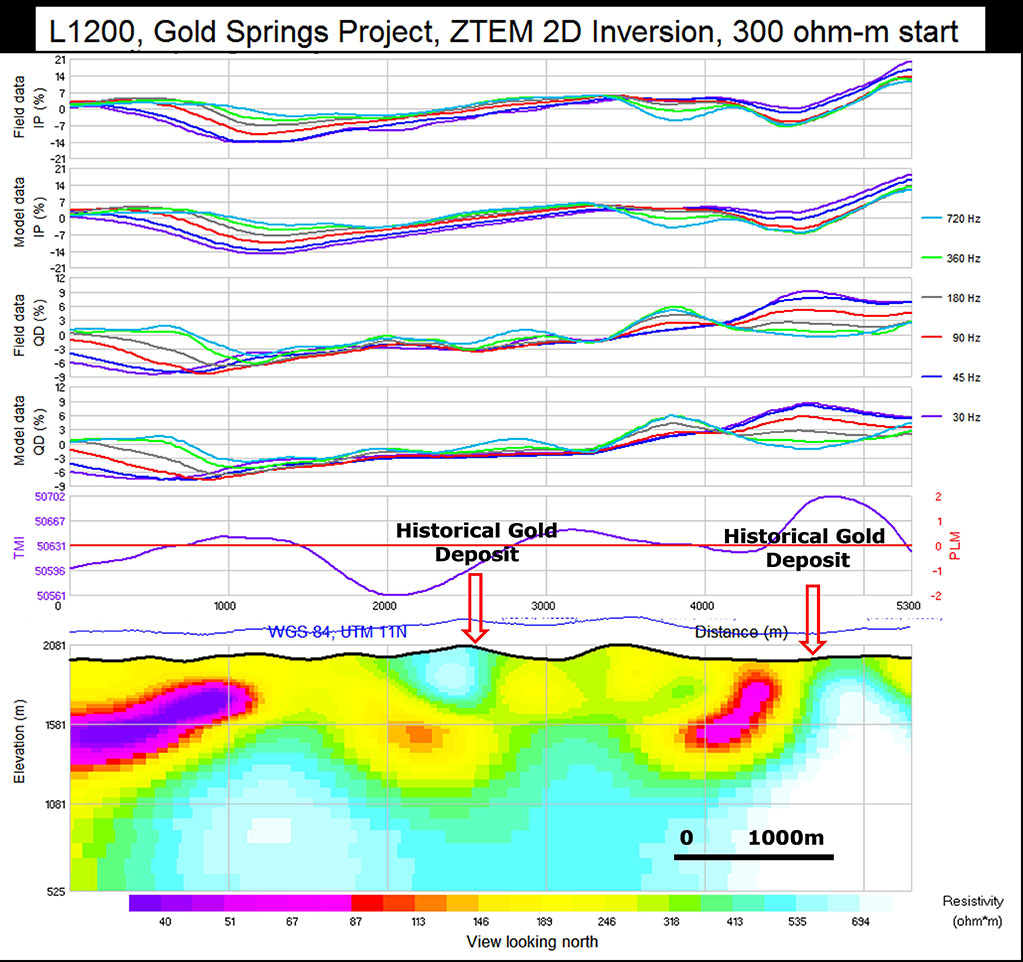Presented at 22nd ASEG, February 2012, Brisbane, Australia
For a PDF of this paper click here
Summary
A ZTEM™ (Z-Tipper Axis Electromagnetic) helicopter AFMAG test survey was conducted in April, 2011, over the Gold Springs Project, in south eastern Nevada, for low sulphide epithermal gold exploration. Previous ground CSAMT surveys at Gold Springs revealed a positive correlation between the known epithermal gold systems and buried, subvertically-dipping resistivity high features that extend to depth. Synthetic forward modeling showed that ZTEM could also be successful, provided topographic effects were accounted for.
The ZTEM test results performed over the known epithermal gold prospect in southeastern Nevada appear to correlate very well with the CSAMT results and the known geology, in particular the presence of all the known epithermal centers over resistivity highs. Similar anomalies have been identified in previously unexplored areas of thicker overburden cover. 2D inversions of the airborne ZTEM, using a newly developed Avert2d code that accounts for bird clearance and 2d topography, appear to agree very well with the inversions obtained from ground CSAMT. These results provide encouragement for the application of ZTEM for epithermal gold deposits elsewhere in the district.
Key words: ZTEM, AFMAG, airborne, electromagnetic, epithermal, gold, resistivity.
Introduction
Exploring for epithermal vein gold deposits has long posed significant challenges for airborne electromagnetic methods, due to the disseminated nature of the sulphides that makes them virtually undetectable using EM, particularly when buried below overburden cover. This is easily the case for low sulphidation epithermal gold-silver vein systems, whose minor sulphide content (<2%) within the silica-rich stockworks, breccias and veins often make them difficult to detect even with ground induced polarization. Indeed, in addition to magnetics, and gravity, electrical methods have been successfully applied in epithermal gold exploration (Williams, 1997), including controlled-source audio-magnetotelluric (CSAMT) surveys (Zonge and Hughes, 1991). Frequency domain airborne EM methods have long been known to be able to successfully map geology based on resistivity contrasts (Palacky and West, 1988; Holladay and Lo, 1997) but are limited by their shallow depth of penetration. More recently, ZTEM (z-axis tipper electromagnetics; Lo and Zang, 2008) airborne AFMAG (Ward, 1959; Thomson et al., 2007) have proven effective in mapping alteration and structure to great depth related to porphyry copper deposits (Lo and Zang, 2008; Paré and Legault 2010; Izarra et al., 2011) and smaller carbonate replacement deposits (CRD) and skarns (Robertson, 2011) as well as shear-hosted gold deposits (Witherly, 2011). ZTEM has therefore been proposed as possible alternative to ground CSAMT for regional exploration for vein-type epithermal gold deposits in Nevada.
A ZTEM helicopter EM survey was conducted in April, 2011 over the Gold Springs Project, located in eastern Lincoln County, Nevada and Western Iron County, Utah, on behalf of High Desert Gold Corporation (Denver, CO). The survey consisted of 41 east-west lines flown at a line spacing of 200 m and 6 north-south tie lines (Figure 1), totalling 470 line-km. The survey included ZTEM helicopter Tipper AFMAG (audio frequency electromagnetics) measurements, as well as aeromagnetics using a caesium magnetometer.
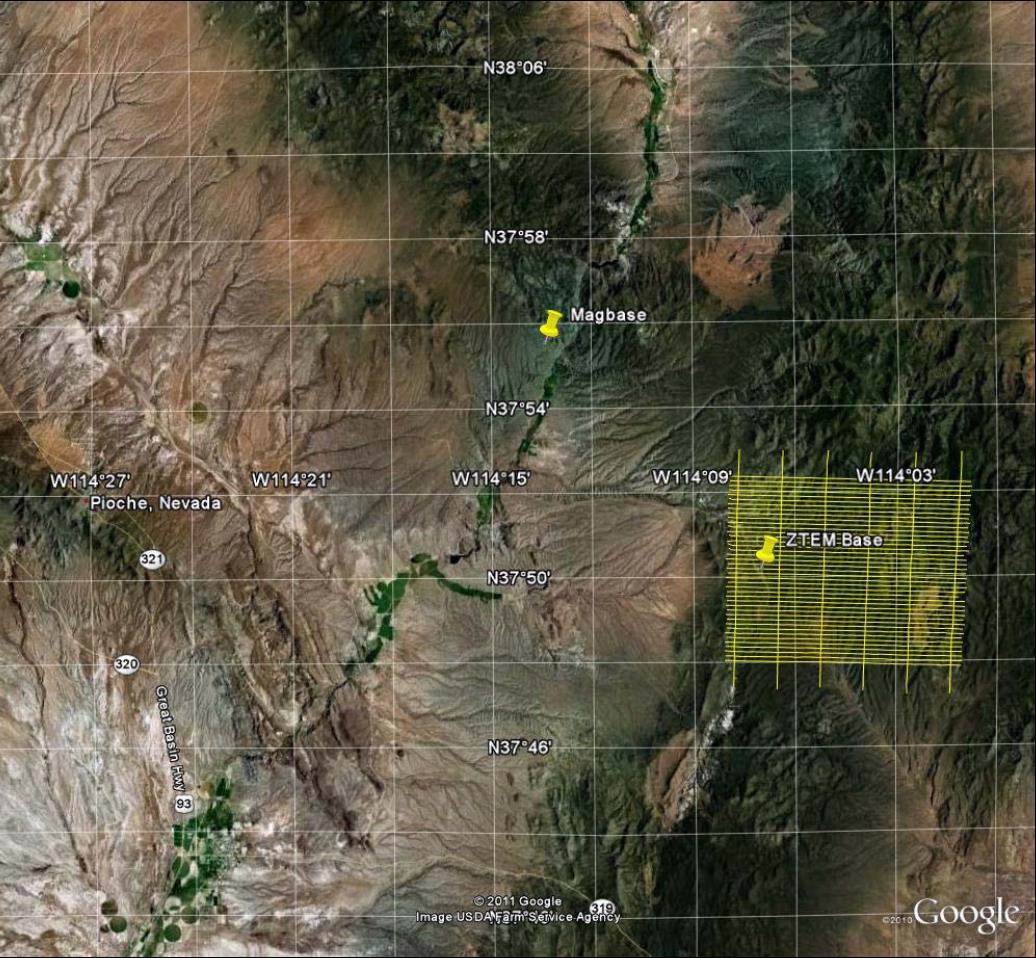
Figure 1. Google Earth image showing property location for Gold Springs Project and ZTEM flight lines.
The Gold Springs district hosted numerous high grade gold-silver mine workings that were discovered in the late 1890’s and where mining continued until the early 1950’s. Gold mineralization is hosted by complex sheeted veins, breccias and stockwork veins which consist of quartz, adularia, and bladed calcite with minor sulphides (<2%) representing low sulphidation, epithermal gold-silver vein systems. At least fourteen discreet gold-silver bearing targets have been identified and are described as large, wide, structural zones, often extending for kilometres along strike. Previous ground CSAMT surveys revealed a positive correlation between the known epithermal gold systems and buried, subvertically-dipping resistivity high features that extend to depth.
The objectives of these ZTEM and magnetic surveys are the following: (1) Define bedrock resistivity structure from ZTEM data. (2) Define bedrock magnetic structure from magnetic data. (3) Identify other similar epithermal gold deposit signatures from both ZTEM and magnetic data.
Geological and Geophysical Model
Epithermal gold deposits form at shallow depths and are near-surface portions of fossil geothermal systems, which contrasts them to porphyry deposits which are formed at greater depth (Williams, 1997). Low sulphidation (LS) epithermal deposits differ from high sulphidation (HS) deposits in the low pH acidity of their hydrothermal fluids. As a general rule, hydrothermal systems lower the bulk resistivity in country rocks, by adding clay minerals and increasing the porosity, permeability and pore salinity. But within the LS system, more intense silicification increases the apparent resistivity, accompanied by magnetite destruction and increased density.
Typically, the LS alteration systems are also mushroom shaped, with significant widening in the near-surface (Figure 2). Whereas HS epithermal zones tend to be more subvertical, are typically vuggy and brecciated within the silica core, with the argillic to propyllitic zoned alteration extending outward, and are more strongly mineralized with disseminated sulphides, primarily pyrite. The relative absence of sulphides in LS epithermal systems, explains why resistivity methods, like CSAMT, are usually the preferred tools used in their exploration.
General Theory
The ZTEM airborne AFMAG system measures the anomalous vertical secondary magnetic fields that are created by the interaction between naturally occurring, plane wave audio- frequency EM fields and electrical heterogeneities in the earth. The vertical magnetic field is linearly related to the horizontal fields according to the following (Vozoff, 1972; Labson et al., 1985):
Hz = TzxHx + TzyHy
where the magnetic field vector T = (Tzx, Tzx), known as the tipper, is complex and a function of frequency, but has rotationally invariant properties, such as its magnitude and direction, that are independent of the subsurface, the measurement direction and the field polarization (Labson et al., 1985).
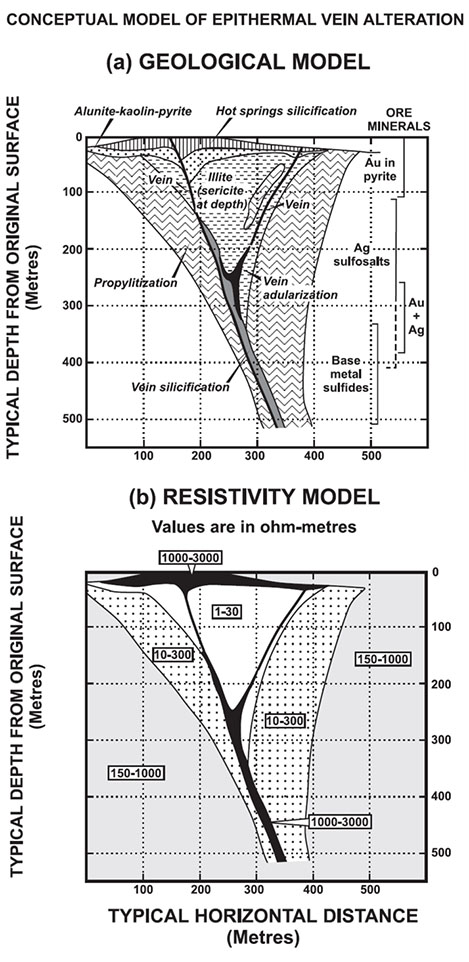
Figure 2: Schematic illustration of cross-sections of (a) a low sulphidation epithermal gold deposit (b) electrical resistivity associated with the different alteration types (modified after Williams, 1997).
AFMAG uses naturally occurring audio frequency magnetic fields from worldwide atmospheric thunderstorm activity as the source of the primary field signal, and therefore requires no transmitter. The primary fields resemble those from VLF except that they are not man-made, are at lower frequency (tens & hundreds of Hz versus tens of kHz), are pseudo-random, rather than periodic, and are usually not as strongly directionally polarized. These EM fields used in AFMAG have the unique characteristic of. being uniform, planar and horizontal, and also propagate vertically into the earth – to great depth, up to several km, as determined by the magnetotelluric (MT) skin depth (Vozoff, 1972):
δS = 503 * √(ρ / ƒ) metres
which is the depth where the amplitudes of the EM fields are reduced to 1/e (37%) of their surface values and is directly proportional to the ratio of the bedrock resistivity to the frequency.
ZTEM is an airborne variant of the AFMAG technique where the vertical dipole axis air-core magnetic receiver towed by the helicopter (Figure 1) is coupled with a fixed ground base station that measures the horizontal primary fields using similar dipole axis magnetic sensors (Thomson et al, 2007; Lo and Zang, 2008).
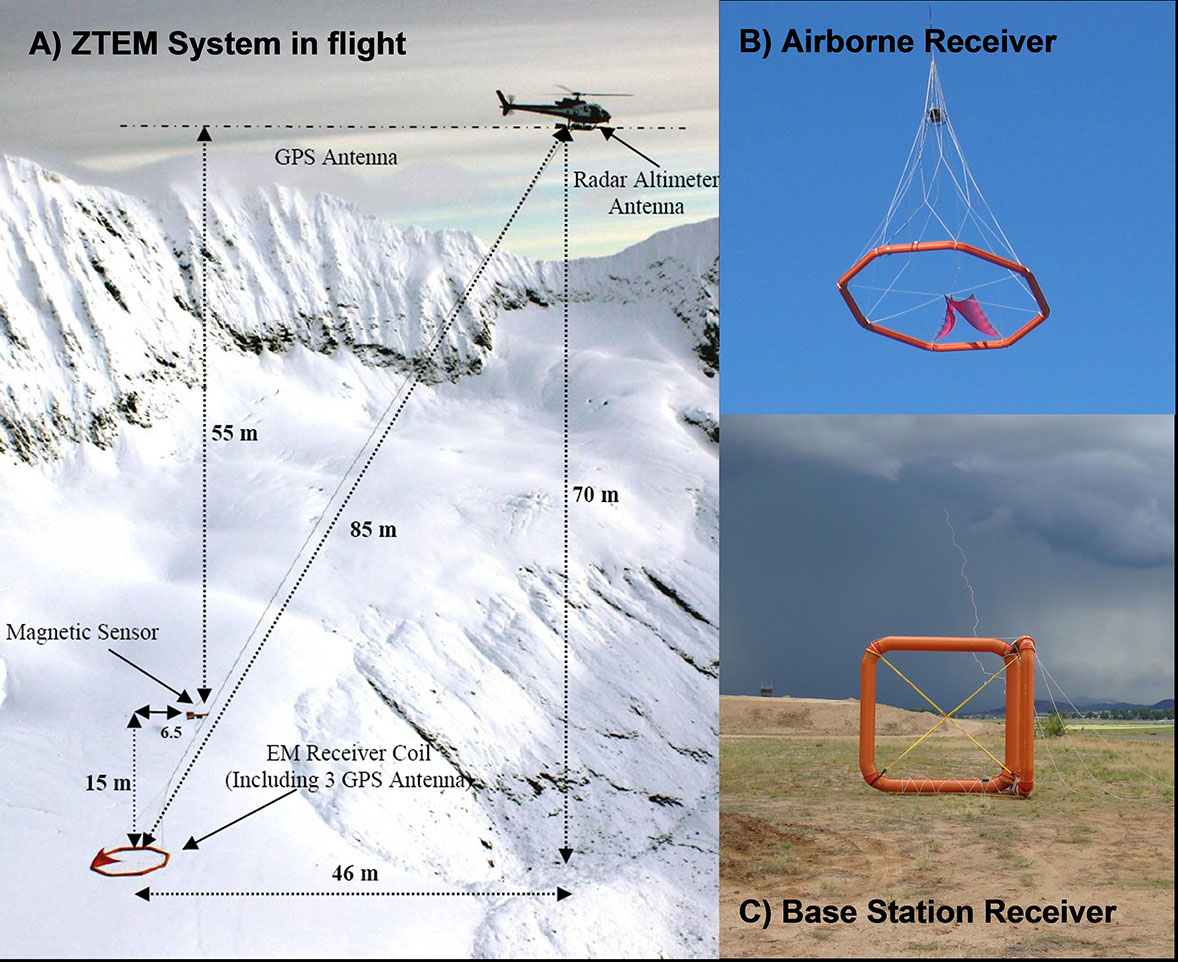
Figure 3. a) ZTEM helicopter EM system in flight, showing Hz receiver Coil and magnetic sensor; b) Hz receiver coil, c) Hx-Hy base station coils located at a remote site adjacent to survey area.
Synthetic Modeling
Using 2D inversion results of previous CSAMT survey data obtained at Gold Springs over one of the many historical gold deposits, as a guide (Figure 4), prior to the survey, 2D synthetic forward modeling was performed to simulate the expected airborne tipper AFMAG responses for a low-sulphidation epithermal geologic model using the 2D forward MT modeling code of Wannamaker et al. (1987).
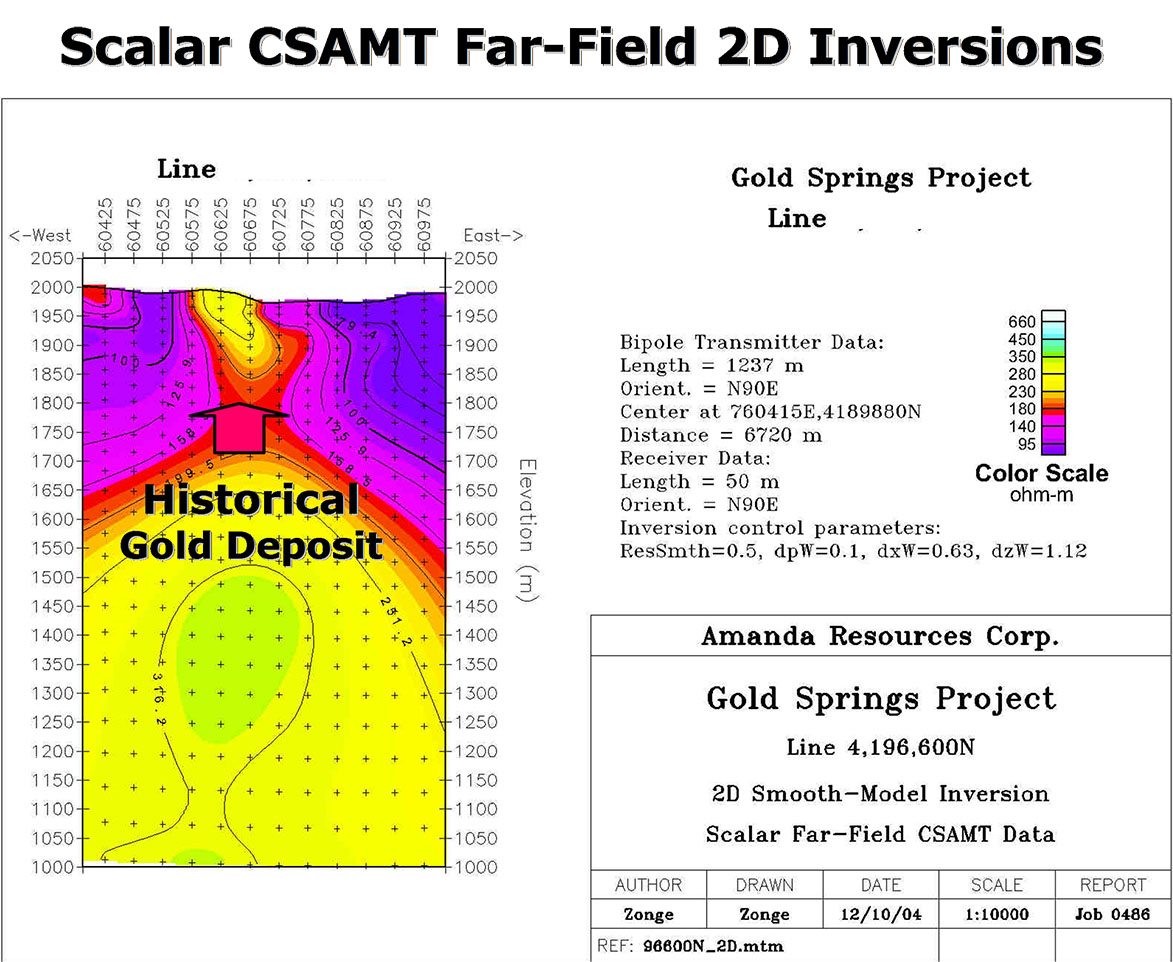
Figure 4: 2D Inversion of scalar CSAMT data obtained over a historical gold det at Gold Springs (by Zonge Engineering; courtesy High Desert Gold Corporation).
Figure 5 presents the 2D synthetic forward model responses of the In-line (Tzx) In-Phase and Quadrature over a mushroom shaped LS epithermal target that resembles the schematic model in Figure 2 and having similar physical properties and dimensions as the 2D CSAMT model in Figure 5, including a topographic high. The results suggest that ZTEM airborne AFMAG could be successful for mapping similar epithermal gold systems as those identified using CSAMT – provided the appropriate topographic corrections are applied during the inversion.
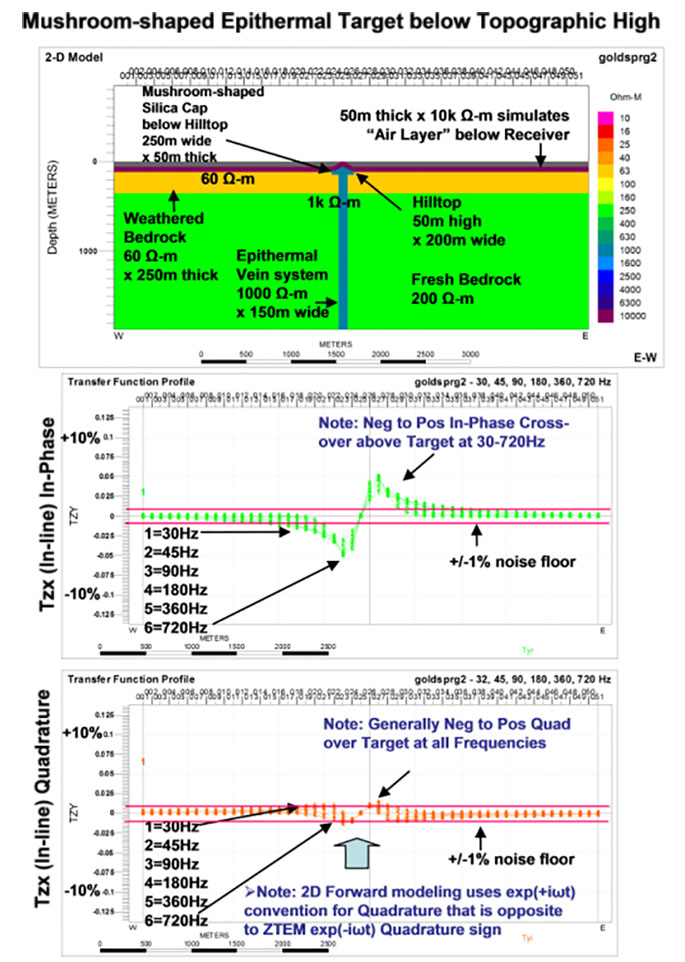
Figure 5: 2D resistivity model of Gold Springs epithermal gold target and related 2D forward modelled airborne In-line tipper profile results.
Results and Discussion
ZTEM Results
DT (Total Divergence) imaging, analogous to the VLF Peaker parameter of Pedersen (1998), converts the ZTEM tipper cross-over data into peak-responses which assists their interpretation in plan. Figure 6 presents the mid-frequency (90Hz) In-Phase DT map along with EM anomaly picks and the location of known gold deposits. Red colours indicate DT low (conductive) areas and the blue colours indicate DT high (resistive) areas. As indicated in the previous ground CSAMT geophysical surveys over the property, the focus for the low-sulphidization epithermal gold targets are in relatively resistive areas. The cluster of resistive areas indicated in the In-Phase DT maps clearly show a good correlation with the known gold deposits, suggesting separate epithermal cells within a volcanic center , which fits the geologic model.
2d Inversion Results
ZTEM tipper results can be readily converted to an equivalent resistivity-depth section using computer 2D or 3D inversion. In this case a new version of the Zvert2d program, described in Legault et al. (2009) and based on the 2D code of de Lugao and Wannamaker (1996), called Av2dtopo, was implemented that accounts topography and bird altitude. The 2D inversions were performed on the Tzx (in-line) component data along the west-east flight direction using all 6 available frequencies (30, 45, 90, 180, 360 and 720 Hz). Using the previous CSAMT 1D and 2D inversion results as a guide, a 300 ohm-m uniform half-space starting model was used throughout. Figure 7 presents the 2D ZTEM inversion results of Line 1200. As shown, the known gold occurrences are all located in resistivity high features.
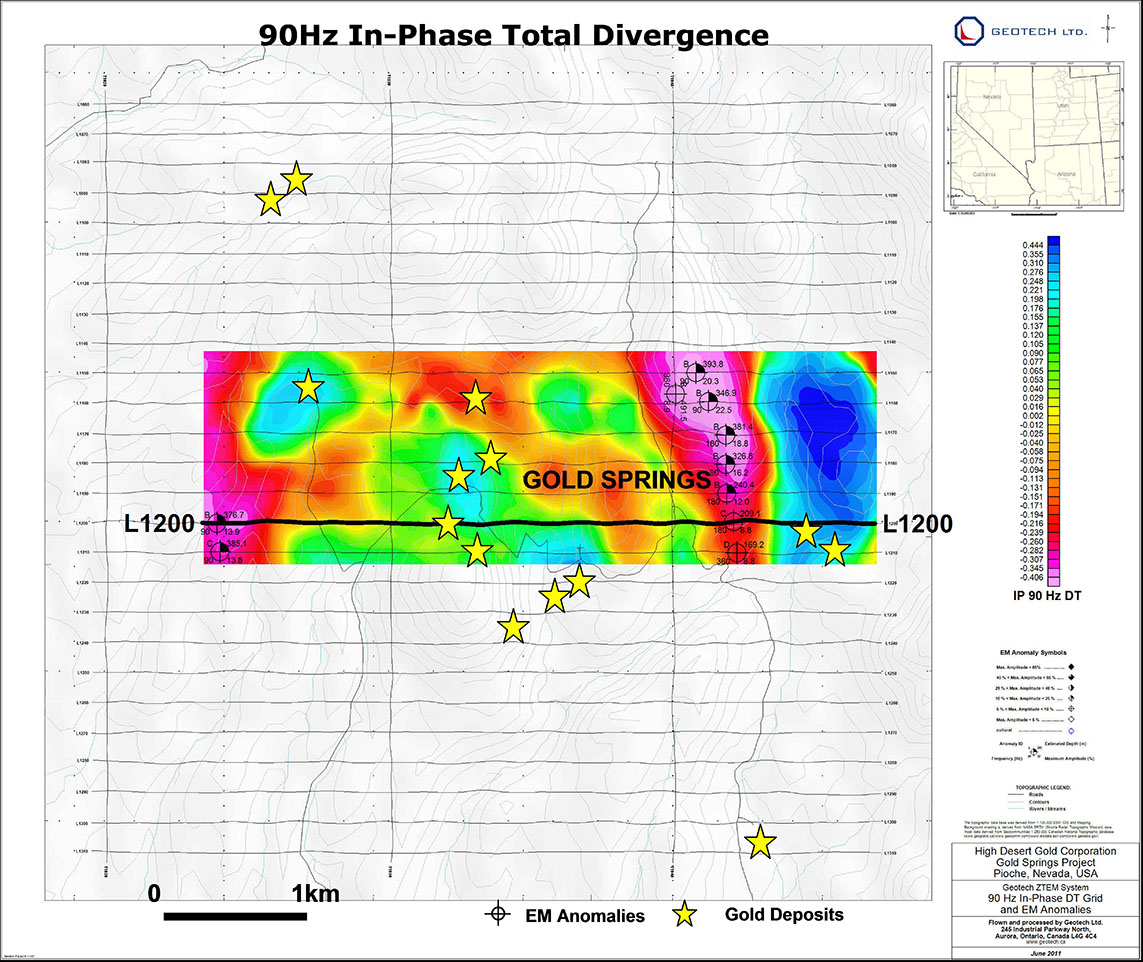
Figure 6. 90Hz In-Phase DT results, EM anomaly picks and historical gold prospects over Gold Springs project
(windowed at client’s request).
Conclusions
ZTEM inversion results indicate that most of the known gold workings/occurrences are located in a region featuring localized zones of high resistivity and high magnetic susceptibility areas, mainly found in the central part of the survey area. The clustering of these resistivity highs suggests they were formed in a volcanic center, which is consistent with the formation of LS epithermal deposits. The survey results also indicate that a number other similar resistive and magnetic anomalies occur further south and west, in areas of overburden cover, which represent promising areas for follow-up. As predicted in the earlier forward modeling analysis, the ZTEM inversion results agree with those obtained from previous CSAMT survey and have extended the mineral potential over a much larger survey area.
Acknowledgements
The authors wish to thank High Desert Gold Corporation and Geotech Ltd. for allowing us to present these results. We also thank Phil Wannamaker for the topographic-correction development to the ZTEM 2D inversion code.
References
De Lugao, P.P., and Wannamaker P., 1996, Calculating the two-dimensional magnetotelluric Jacobian in finite elements using reciprocity, Geophysical Journal International, 127, 806-810.
Izarra, C., Legault, J.M., and Fontura, C., 2011, ZTEM airborne tipper AFMAG results over the Copaquire Porphyry, northern Chile, SBGF Conference Expanded Abstracts, 4pp.
Labson, V. F., Becker A., Morrison, H. F., and Conti, U. , 1985, Geophysical exploration with audio frequency natural magnetic fields, Geophysics, 50, 656-664.
Legault, J.M., Kumar H., Milicevic B., and Wannamaker P., 2009, ZTEM tipper AFMAG and 2D Inversion results over an unconformity uranium target in northern Saskatchewan, SEG Expanded Abstracts, 28, 1277-1281.
Lo, B., and Zang, M., 2008. Numerical modeling of Z-TEM (airborne AFMAG) responses to guide exploration strategies, SEG Expanded Abstracts, 27, 1098-1101.
Palacky, G.J., and West, G.F., 1988, Airborne electromagnetic methods, in “Electromagnetic Methods in Applied Geophysics, V. 2. Application”, edited by M.N. Nabighian, 811-879.
Paré, P., and J. M. Legault, 2010, Ground IP-resistivity and airborne SPECTREM and helicopter ZTEM survey results over Pebble copper-moly-gold porphyry deposit, Alaska, SEG Expanded Abstracts, 1734-1738.
Robertson, K., 2011, The 2009 Pozo Seco molybdenum-gold discovery, presented at KEGS Symposium, Toronto, CAN.
Thomson, S., Fountain, D., and Watts, T., 2007, Airborne geophysics – evolution and revolution, in “Proceedings of Exploration 07: Fifth Decennial International Conference on Mineral Exploration”, edited by B. Milkereit, 19-37
Wannamaker, P. E., Stodt, J. A., and Rijo, L., 1987, A stable finite element solution for two dimensional magnetotelluric modeling: Geophysical Journal of Royal Astronomical Society, 88, 277-296.
Ward, S. H., 1959, AFMAG – Airborne and Ground: Geophysics, 24, 761-787.
Williams, P.K., 1997, Towards a multidisciplinary integrated exploration process for gold discovery, In “Proceedings of Exploration 97: Fourth Decennial International Conference on Mineral Exploration” edited by A.G. Gubins, 1015–1028.
Witherly, K., 2011, ZTEM for precious metals exploration: Extending the envelope, presented at PDAC-CAMESE Exhibitors Innovation Forum, Toronto, CAN.
Zonge, K.L., and Hughes, L.J., 1988, Controlled source audio-frequency magnetotellurics, in “Electromagnetic Methods in Applied Geophysics, V. 2. Application”, edited by M.N. Nabighian, 713-807
